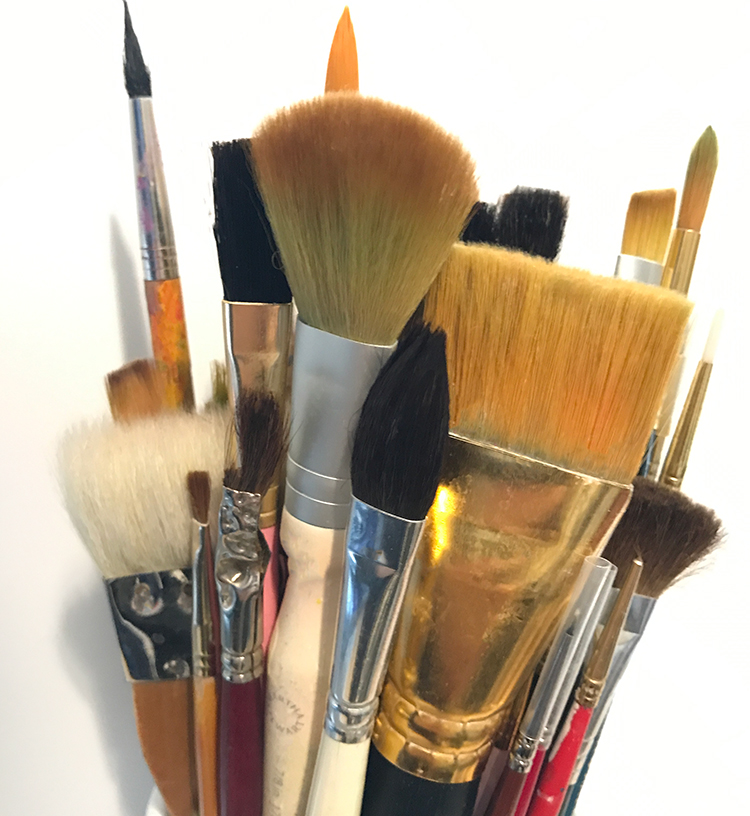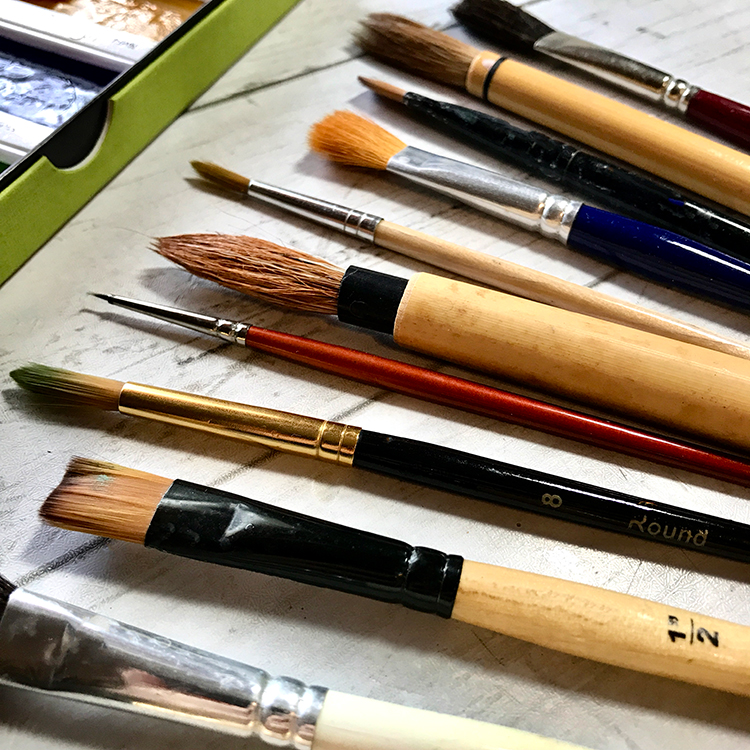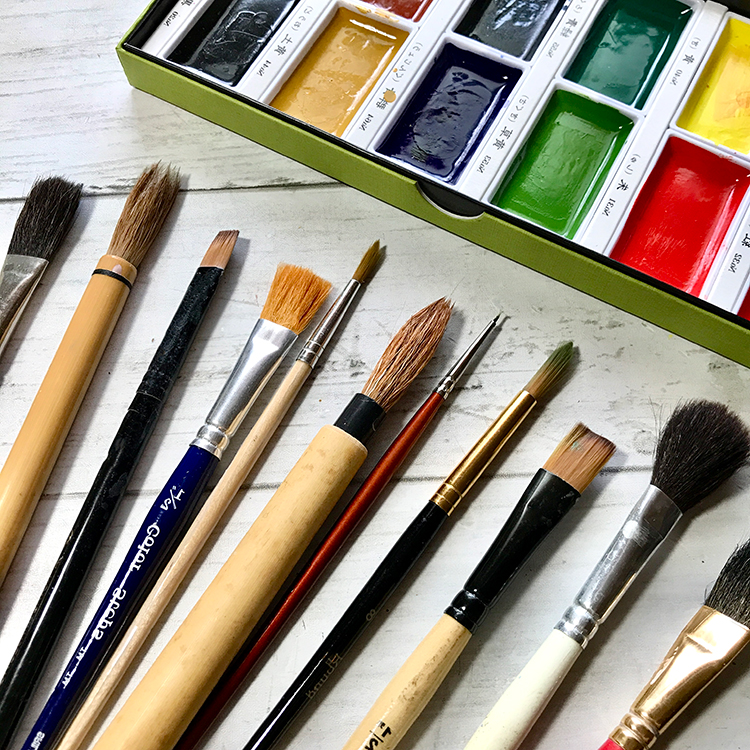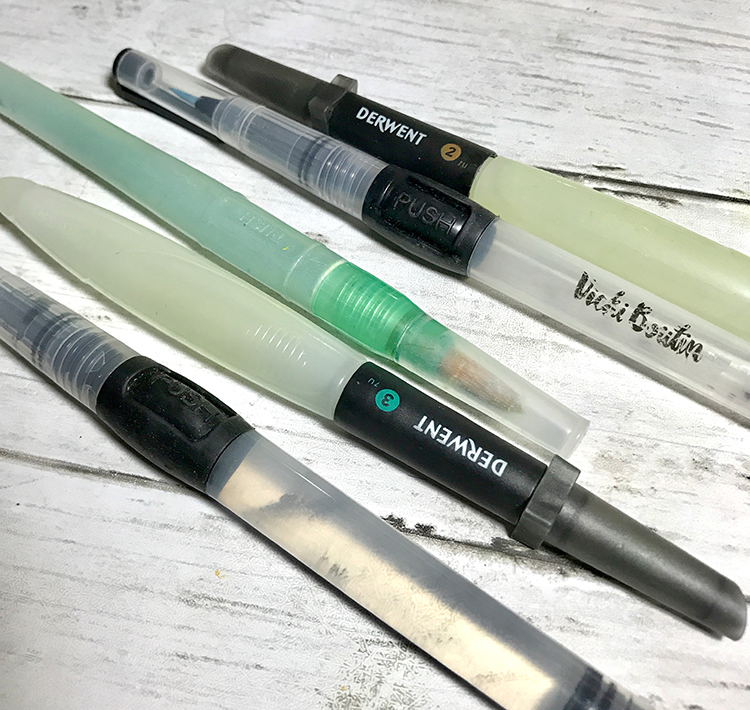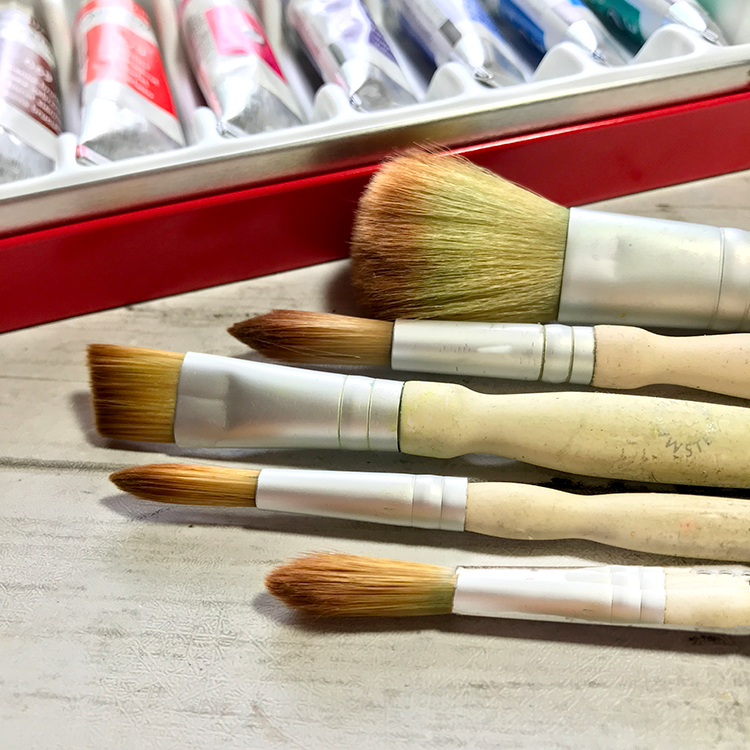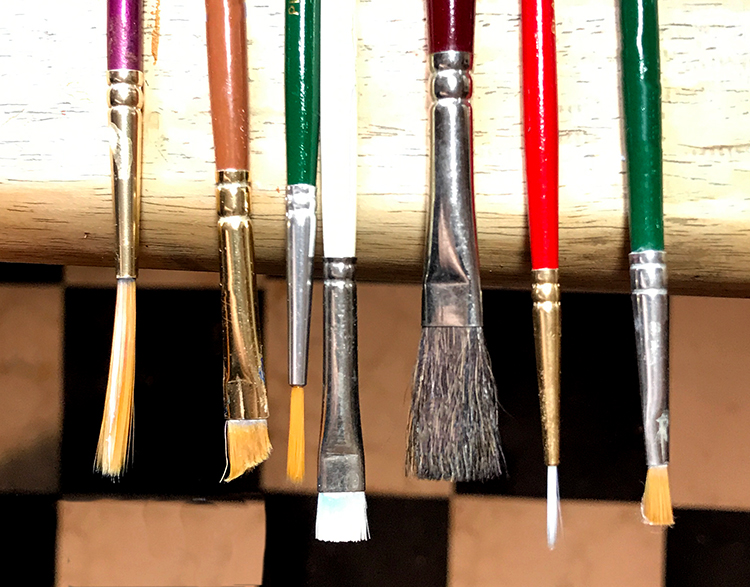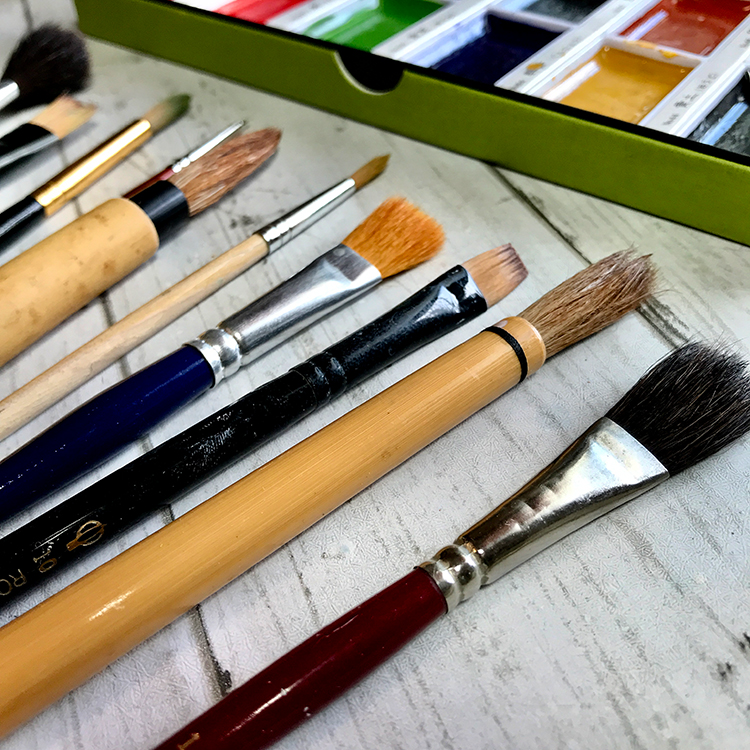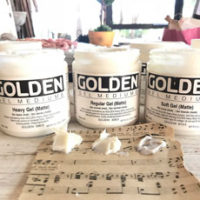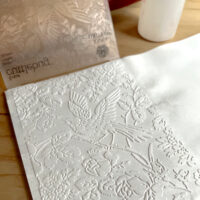Best Paint Brushes for Watercolor
Hello my artful Graphics Fairy friends – it’s Rebecca here to share my thoughts on the Best Paint Brushes for Watercolor with you! Watercolor brushes are necessary tools for artists wanting to express their unique, creative ideas in watercolor. But there are so many styles and brands that it can be a little confusing. That’s where this guide comes in. I will be explaining the different brush shapes individually and what they are used for as well as the best brushes for beginners, intermediate, and advanced painters. Then we will review how to clean and store them so that they last a long time.
Watercolor Brushes
Brushes are a really important part of painting with watercolors, and you don’t just use one brush. For watercolor painting, you will need a variety of brushes in different sizes and also different shapes and types. This is beneficial since you don’t need 20 of each shape brush.
For best results, watercolor brushes need to be of high quality. Otherwise, the results of your watercolor artistic endeavors can be highly unpredictable. It can be challenging however to choose the right brush for several reasons. There is quite a variety of shapes, sizes, and hair types. Some use natural hair while others are synthetic or a combination of the two.
Additionally, watercolor brushes are labeled with numbers, which can be confusing, especially for beginners. Brushes are generally sized in a numerical scale for the width and length of the hairs of the brush. This numbering system is generally used for round and flat brushes. Other types are numbered based upon their length and width. Unfortunately, there is no industry standard. A number 10 round from one manufacturer might be very different from another. Even the same manufacturer may not number their brushes the same from series to series. UGH!!! Let me try to demystify watercolor brushes for you.
Selecting a Watercolor Brush
When selecting a particular brush, three primary factors should be considered – performance, resilience, and cost. A brush should be capable of holding a significant amount of water or paint in its belly, maintain a fine point, and spread the medium evenly and smoothly on the surface. The brush should be able to spring back (known as snap) to its original, normal shape after each use and maintain that shape for a considerable length of time. You also need to consider what you can comfortably afford. Some watercolor brushes can cost several hundred dollars, so you want to make sure that you love watercolor painting and will be creating with them for a long time before you make those brush choices.
Watercolor brushes generally have smaller and shorter handles than brushes that are used for oil and acrylic painting. Smaller sized paintings are typically created by most watercolor artists. This requires working considerably closer to the paper or surface. Optimum brush control comes with practice and trying different brushes. Most of the good art supply stores allow you to try out watercolor brushes before you buy them. I recommend this testing highly.
Styles of Watercolor Brushes
Synthetic versus Sable
There are soft and hard bristles, natural and synthetic, flats and rounds, and specialty brushes. Watercolor brushes come in different hair types:
- Synthetic means man-made fibers. The synthetic brushes tend to hold a little less water than the Kolinsky or the sable. Synthetics have stiff bristles. And they also don’t hold their point as beautifully over time as the sable. The only problem with the synthetic is that it tends to become splayed rather quickly. And when you’re painting and you want a nice point, you don’t want a brush that looks like a broom. Synthetic brushes are a lower cost alternative. They have a tendency to hold less paint and are considerably stiffer than sable hair brushes. Additionally, the paint cannot be distributed as evenly because the bristles are too smooth. These brushes are usually made from nylon or polyester.
- Sable or Kolinsky are made with animal hairs. Animal hair holds a lot of water and makes a beautiful point. A Kolinsky brush holds a ton of pigment. It’s almost like a sponge holding a ton of pigment and water. The premier watercolor brushes (along with being the highest cost), are made of sable hair. Of these, the one that is typically acknowledged as the finest is called the Kolinsky sable, which can cost more than $1,000.00 for a single brush! Interestingly, the hair comes from the tail of a species of weasel instead of a sable from the Kolinsky region of Siberia. Most Kolinsky sable brushes are made from a combination of around 60/40 male-to-female hair. It’s beautiful brush… and very pricey. Sable hair has the qualities of holding lots of water, maintaining its shape, and has a sharp point. I love sable brushes, but only have a few.
- Blended Brushes are made with a combination of natural and artificial hairs. These brushes have properties of both the other brushes and are a good choice for advanced beginners or intermediate painters. They provide the artist a feel for the strokes and handling of pure, natural bristle brushes without the higher price point. They cost a little more than synthetic and less than pure sable.
It should be noted that as is common with art supplies, selecting paintbrushes for watercolors essentially comes down to personal preference. A large part of this is affordability along with your preferred watercolor techniques and how different brushes feel in your hand.
Shapes of Watercolor Brushes
The two most commonly used shapes of watercolor brushes are round and flat, especially for beginners. Other brush shapes are useful for different applications as one’s skill level increases. You would only use these because when you need them to do some particular the work for you. You want to use your tools to their greatest advantage. For instance, the shorter the hairs or bristles of a brush, the greater the control you’ll have as you paint. Longer hair brushes are harder to control. However, they create expressive marks and strokes. The point is that you try to work smart, not hard. And painting should be fun!!! It is good to have at least three sizes of a particular type of brush.
- Round. A round brush doesn’t really look round. It actually has a point. But these are referred to, and it says right on the brush, a “Round Tip Brush.” Round brushes are the most commonly used of all due to the ease of creating small, delicate, detailed lines as well as larger, broader strokes and washes. This brush is a nice tool for making beautiful, thin and varied lines: thick to thin, thin to thick. It provides a lot of control. You could go very fine or very thick by the pressure and positioning of the brush on the paper. It is good to have at least three sizes of a particular type of brush – small, medium, large. So for rounds, I recommend one – #1, 2, or 3; one – #4, 5, or 6; and then a really big one – #10 or 12. The biggest rounds also have a beautiful point, which creates a fatter mark.
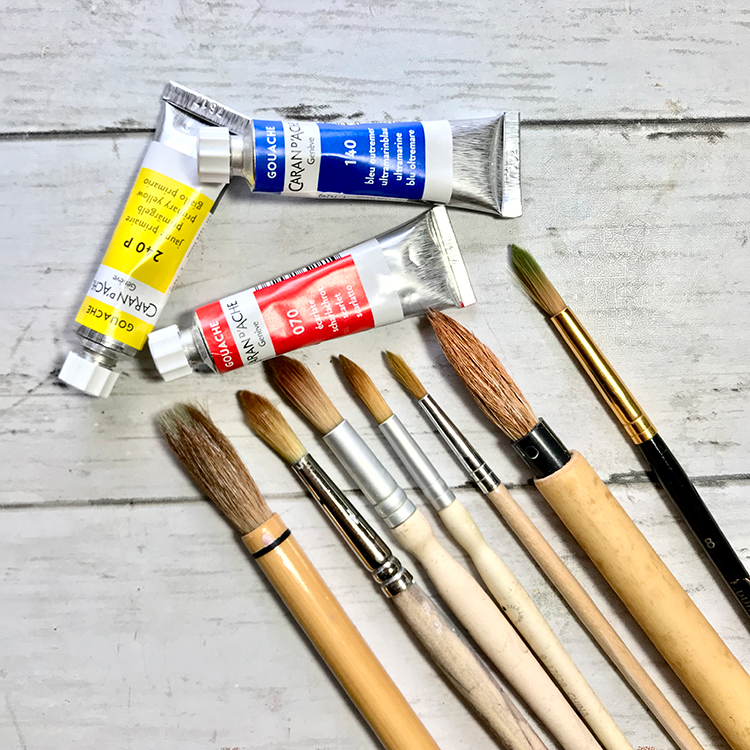
- Flat Flat brushes are not quite as versatile as round ones, but are ideal for washes and linear (square and rectangular) strokes along with thin strokes when applied with the side of the brush. These are square tip brushes. This brush is meant to paint anything with a square, angular, or straight line shape when you are trying to get a clean edge. It is also used to make a gradient where you’re trying to get a lot of coverage. Artists usually go by the width of the flat brush instead of a number. A favorite size is an inch or so wide, but it is nice to also have a smaller version or two. If you are doing really big paintings, you might get an even fatter square tip brush.
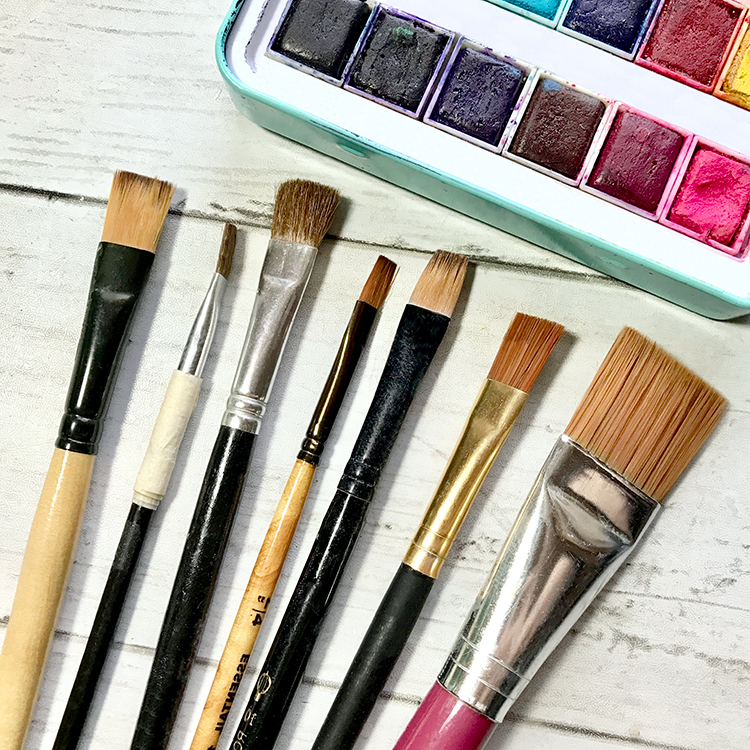
- Wash Wash brushes are basically just a wider version of a flat brush used for larger washings and linear strokes. A 2″ is my favorite, but they can go up to 5″ wide. Squirrel and goat hairs are often used for the bristles, with hog hairs typically used on the largest wash brushes.
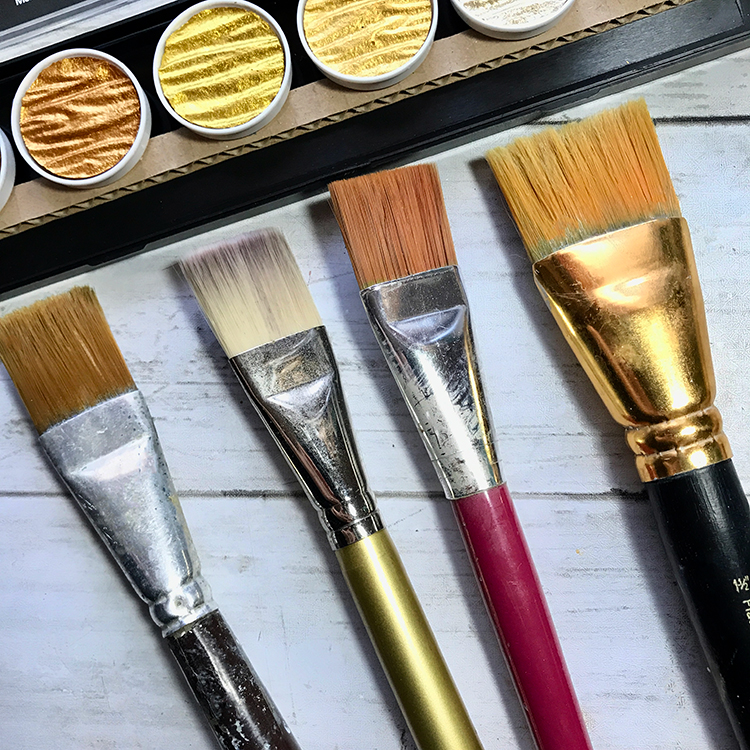
- Mop Mop brushes are usually large, floppy bristle/hair brushes that are meant to cover large areas of a painting with watercolor, quickly. They carry lots of water and are generally used in a loose style. The best mops are made of natural hair. Mops are ideal for soft applications and glazing since they hold lots of paint. Plus, they come to an amazing point. You can paint with one load of the brush and then you can get a real variety of brush strokes out of them. They have a very specific shape when dry. There is also and unshaped, domed style that resembles a makeup powder brush. One or two of these should be plenty.
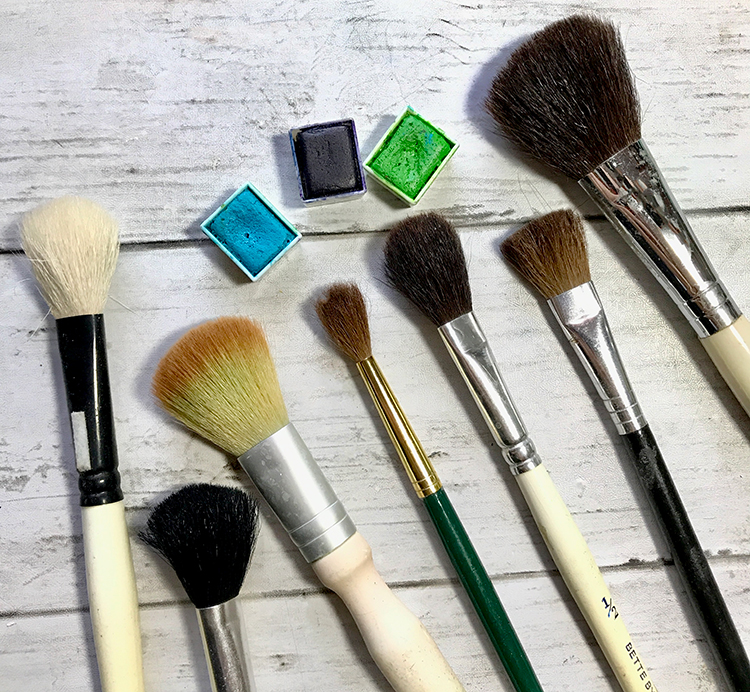
- Oval Filberts Filberts are essentially flat brushes that have rounded tips. They are specifically designed for blending or shaping curved areas within a wash or leaving a soft tail on a wet stroke. These brushes are also great for absorbing and removing excess water or paint from the surface (see scrubber below). Squirrel and goat hairs are often used for the bristles on these brushes as well. I absolutely love to paint with a filbert, which is literally round. It is meant for creating organic or round shapes. It is awesome for painting in rounded areas. Plus, you can easily make a circle with it. And good circles are hard to make. And again, it is good to have three different size of the filbert – small is a 4 or 6, medium is a 10; and large is a 20.
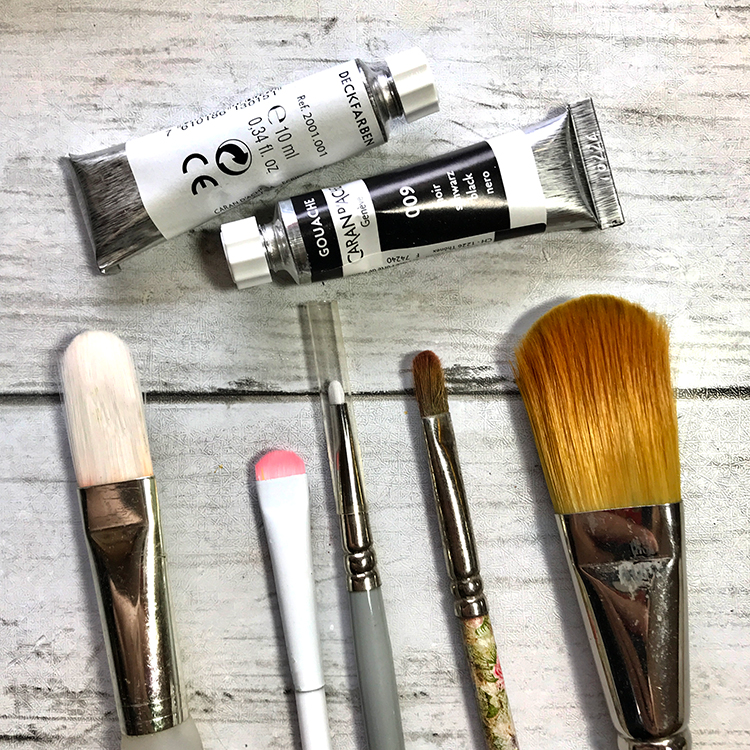
- Angular Another interesting brush is an angular brush. It gives you a wonderful ability to turn corners because of the shape of the tip of this brush. This is a great brush to have for painting architecture and when you need to get into a corner, where a kind of turn or twist is required. You cannot do this sort of thing with other brushes because they are not designed that way. Small is a 4-6, medium is a 10, and large is a 14+.
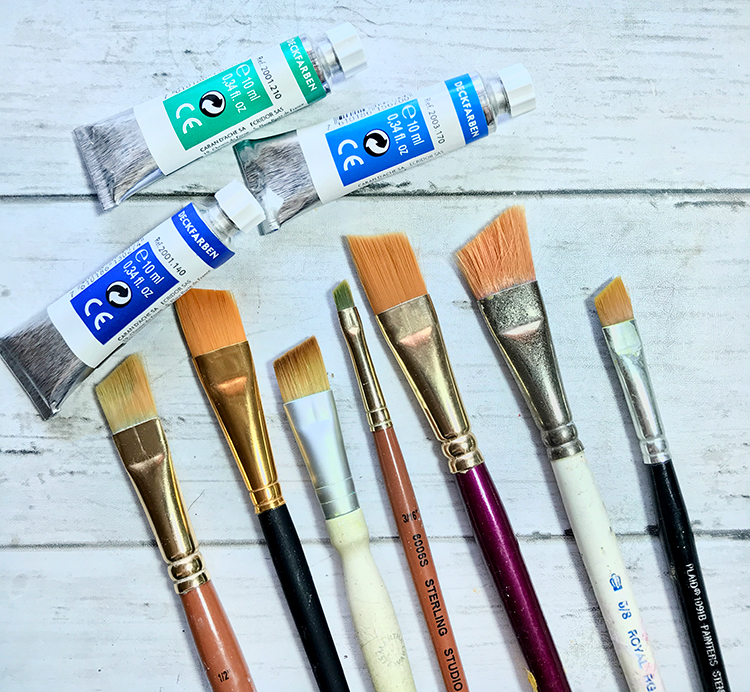
- Spotter Spotter brushes are small, round ones that have shorter bristles for optimal control. These are also known as retouching brushes for their ability to produce minute details. A smaller size is a good one. Here are mine in their protective sleeves.
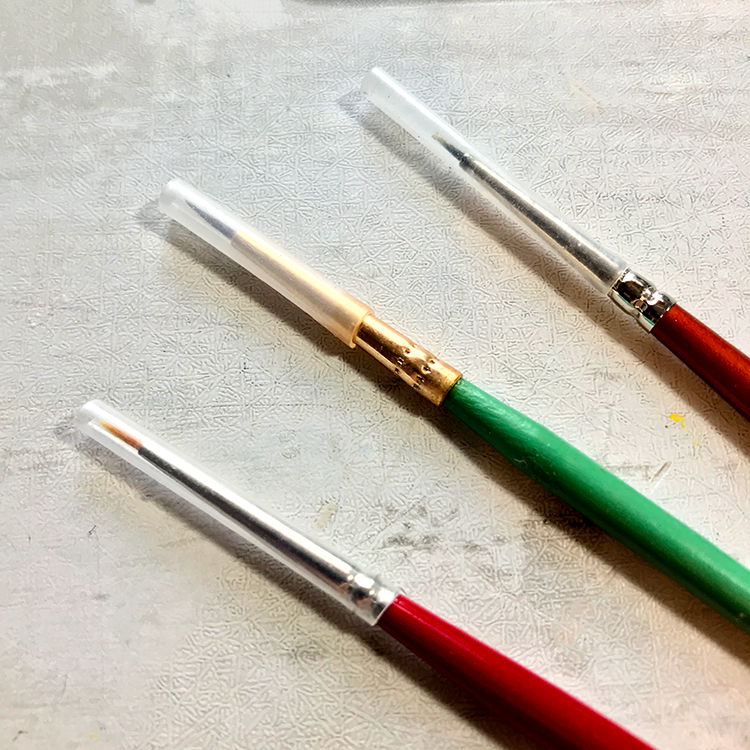
- Rigger, Striper, and Liner This group of small watercolor brushes with long tufts (bristles) is specific to creating very fine lines or script. Some people call them a liner brush, a small and skinny brush that has long hairs but not very many. Long, continuous lines of equal varying widths can be created with these brushes that hold lots of paint and are relatively easy to control once you master the arm movements.
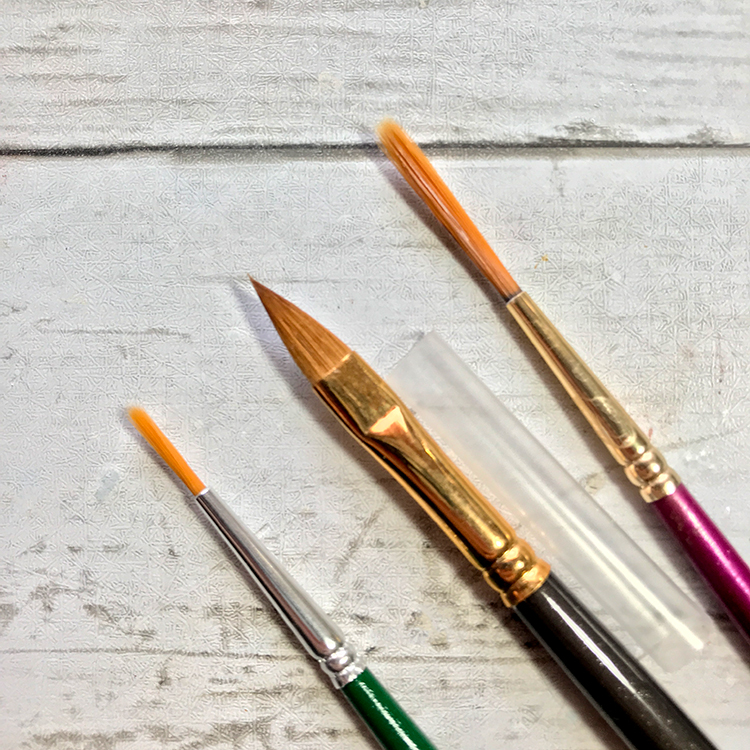 Rigger brushes get their name form being used to paint the rigging on sailing ships while the striper name is derived from auto and sign painters. Liner brushes have the longest tuft with superior snap and paint capacity. They are used for some of your calligraphic strokes and things like limbs on a tree. Here is my most expensive brush – a handmade rigger from France.
Rigger brushes get their name form being used to paint the rigging on sailing ships while the striper name is derived from auto and sign painters. Liner brushes have the longest tuft with superior snap and paint capacity. They are used for some of your calligraphic strokes and things like limbs on a tree. Here is my most expensive brush – a handmade rigger from France. -
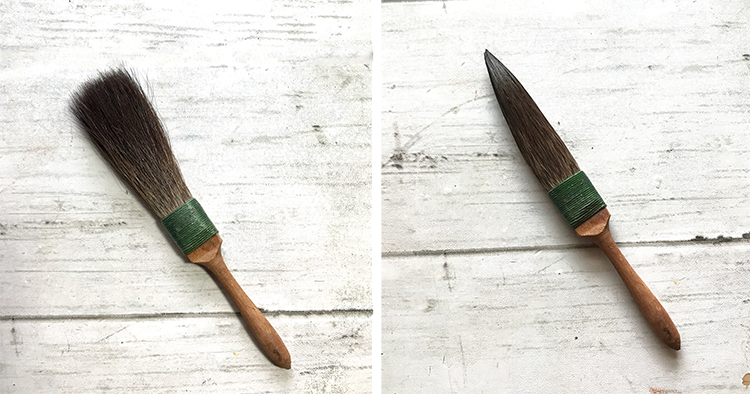 Scrubber It is not a brush that you paint with. It one that you lift paint off the surface with; basically scrub out. It MUST only be used after your watercolor is dry. You scrub from an absolutely bone dry sheet of paper. Otherwise you will scrub up the pulp and you’ll start getting little paper pills. It will be very hard to paint on your paper again. It is very handy to have when you are learning watercolor.
Scrubber It is not a brush that you paint with. It one that you lift paint off the surface with; basically scrub out. It MUST only be used after your watercolor is dry. You scrub from an absolutely bone dry sheet of paper. Otherwise you will scrub up the pulp and you’ll start getting little paper pills. It will be very hard to paint on your paper again. It is very handy to have when you are learning watercolor.
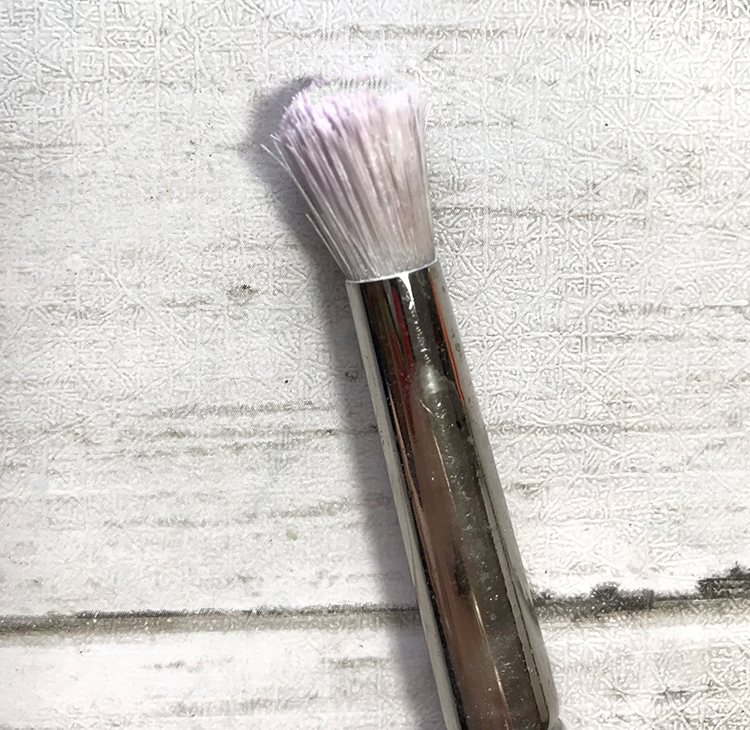
Water Brushes
These types of brushes should not be confused with watercolor brushes. Water Brushes have plastic barrels that hold water and are dipped in the paint and squeezed. They are fun brushes to play with and are great for travel when a water container might be unavailable. It works really well with the portable set. The brush tips synthetic and are of lower quality than watercolor brushes. Just like with the regular brushes, they come in a variety of shapes and sizes. You can get a really fine point. You can get a medium point. You can get rounds and square tips. I use a syringe to put water in it. You don’t need to put your brush into a water bowl because the water is in the handle. You squeeze out a little water by literally just pinching it. It’s beautifully flexible and almost works like a marker. Remember to put the cap back on, like a pen. The hair won’t last that long. These are not expensive brushes, so you can easily replace them, unlike your Kolinsky or sable. You go through these and just buy a new one.
Watercolor Brushes for Beginners
Beginners may want to consider a round or flat synthetic brushes to start, as they are easy to make both larger and smaller strokes. A good recommendation to start would include three round brushes. These will really be all you need to get started because of their versatility, ease of use, and low cost. The approximate sizes shown below are common for round brushes.
- Small Size (2-3)
- Medium (Size 5-8)
- Large (Size 12)
A splendid choice for the novice is in the medium category, with a size 6 being possibly the best option, as it small enough for fine details yet big enough for painting larger areas. A size 2 or 3 is a fine option for your second brush, allowing for finer details and producing smaller paintings.
A few good choices for novice watercolor artists are:
- Silver Black Velvet Basic Watercolor Set
- Princeton Velvetouch, Mixed-Media Brushes
- Winsor and Newton Cotman Short Handle Set
- Princeton Series 3750 Select Synthetic
- MozArt Supplies Essential Watercolor set
Watercolor Brushes for Intermediate Artists
When you need more precision and want exceptional performance from your brushes and have established a love for watercolor and are painting with them regularly, it is time to start upgrading your brushes and moving toward more natural hair options. You will be surprised at the difference the hair of the brush will make to your work and your style. It absorbs and releases paint efficiently that accentuates even the tiniest details in your work.
- Winsor & Newton Cotman Watercolor Series 7 Brush
- Da Vinci Maestro Series 10 Watercolor Brush
- Princeton Heritage Series 4050 Synthetic Sable Brushes
- Escoda Versatil synthetic Kolinsky Brushes
Watercolor Brushes for Advanced Artists
Sable and Kolinsky brushes are the preferred choice for most advanced level artists, including professionals. Although available in a variety of shapes, Round brushes tend to be the most popular choice since they hold a point while maintaining their shape. Some Sable brushes are known as ‘Pure Sable’ or ‘Red Sable,’ which are lower quality but a decent choice if you are on a budget. There are several brands of brushes which are universally considered to be outstanding. These include:
- Winsor and Newton Series 7 Kolinsky Sable
- Escada Reserva 1212 Series
- Raphael Kolinsky Sable Fine Point Brushes
- Dick Blick’s Master Kolinsky Sable
- Da Vinci Russian Red Sable Brush Set (Economical Option)
Cleaning Watercolor Brushes
Compared to some other mediums such as acrylics or oils, the water soluble watercolors on watercolor brushes are easier to clean. However, over time, paint deposits and other debris like dirt and dust can accumulate in the brush hairs, especially near the ferrule. Therefore, it is wise to clean your brushes after each use. Typically all you need is a mild soap and warm water, followed by drying with a clean rag. You have to be very careful of your brush hairs and your brush tips. You want to make sure that at the end of every painting session you re-form them. For Rounds you want to re-shape them into a point. For Flats you want to clean and re-shape them into their nice flat shape. Then you need to carry them around in some kind of brush holder that will protect the ends. The brush head and ferrule should both be dry. To ensure that full drying occurs, you may want to lay your brushes flat over the edge of your table for a while so that any excess water can run off and dry naturally.
One thing you should remember: Try to clean your brushes in very lukewarm, soapy water. If you don’t have soapy water available, just use good clean water and try to get us much of the pigment out of the brush as you possibly can so that you’ll have a better brush to paint with the next time. Never use hot water because it can get down into the ferrule of the brush and the brush fibers in place, softening the glue and allowing the brush fibers to come out.
Storing Watercolor Brushes
You don’t want to leave your brushes sitting in a bowl with the hair being pressed sideways. I have done this, so I know from experience. It ruins your brushes. Additionally, if you leave your brushes sitting in water for too long it starts to peel away the plastic in the wood. It just deteriorates the brush. So a fabric brush holder is a wonderful thing to have. I definitely suggest investing in it. It is fine to simply store your brushes in a jar, glass, or cup, for example. The important thing to remember is to set them in an upright (bristles facing upward) position and to not bundle them close together. Giving the brushes room to ‘breathe’ to prevent mold growth and getting bent out of shape is the goal here. If you have protective tubes for your brushes, it is a smart practice to use them to protect the bristles when traveling with them. A good travel case is also a consideration. You need a brush holder to protect your brushes.
I hope you enjoyed our comprehensive guide on the “Best Paint Brushes for Watercolor!” I had so much fun writing this and reviewing my brushes, that I think I will be gifting myself some new ones soon. You might also like my Drawing Supplies for Beginners HERE or my Watercolor Supplies a Comprehensive Guide HERE!
When I am not creating for TGF, I also create Photoshop Elements tutorials and craft project videos over on The Graphics Fairy Premium Membership site. You can find even more of my books, art, and whimsical shenanigans on my website – The Bookery.
May joy be with you all,
Rebecca
